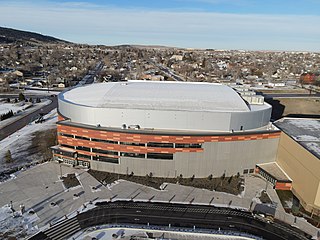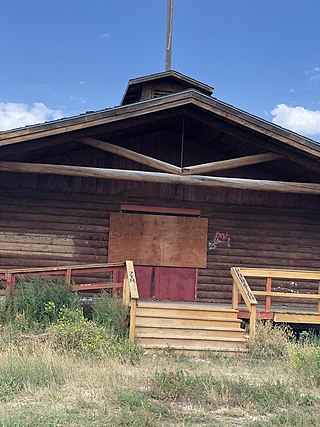
The Lakota are a Native American people. Also known as the Teton Sioux, they are one of the three prominent subcultures of the Sioux people, with the Eastern Dakota (Santee) and Western Dakota (Wičhíyena). Their current lands are in North and South Dakota. They speak Lakȟótiyapi—the Lakota language, the westernmost of three closely related languages that belong to the Siouan language family.

The Wounded Knee Massacre, also known as the Battle of Wounded Knee, was the deadliest mass shooting in American history, involving nearly three hundred Lakota people shot and killed by soldiers of the United States Army. The massacre, part of what the U.S. military called the Pine Ridge Campaign, occurred on December 29, 1890, near Wounded Knee Creek on the Lakota Pine Ridge Indian Reservation in South Dakota, following a botched attempt to disarm the Lakota camp. The previous day, a detachment of the U.S. 7th Cavalry Regiment commanded by Major Samuel M. Whitside approached Spotted Elk's band of Miniconjou Lakota and 38 Hunkpapa Lakota near Porcupine Butte and escorted them five miles westward to Wounded Knee Creek, where they made camp. The remainder of the 7th Cavalry Regiment, led by Colonel James W. Forsyth, arrived and surrounded the encampment. The regiment was supported by a battery of four Hotchkiss mountain guns. The Army was catering to the anxiety of settlers who called the conflict the Messiah War and were worried the Ghost Dance signified a potentially dangerous Sioux resurgence. Historian Jeffrey Ostler wrote in 2004, "Wounded Knee was not made up of a series of discrete unconnected events. Instead, from the disarming to the burial of the dead, it consisted of a series of acts held together by an underlying logic of racist domination."

The Pine Ridge Indian Reservation, also called Pine Ridge Agency, is an Oglala Lakota Indian reservation located in the U.S. state of South Dakota, with a small portion of it extending into Nebraska. Originally included within the territory of the Great Sioux Reservation, Pine Ridge was created by the Act of March 2, 1889, 25 Stat. 888. in the southwest corner of South Dakota on the Nebraska border. It consists of 3,468.85 sq mi (8,984 km2) of land area and is one of the largest reservations in the United States.

Russell Charles Means [wə̃blɪ ohitika] was an Oglala Lakota activist for the rights of Native Americans, libertarian political activist, actor, musician and writer. He became a prominent member of the American Indian Movement (AIM) after joining the organization in 1968 and helped organize notable events that attracted national and international media coverage.

Dennis J. Banks was a Native American activist, teacher, and author. He was a longtime leader of the American Indian Movement, which he co-founded in Minneapolis, Minnesota in 1968 to represent urban Indians. He was a pre-eminent spokesman for Native Americans. His protests won government concessions and created national attention and sympathy for the oppression and endemic social and economic conditions for Native Americans.

The Ghost Dance War was the military reaction of the United States government against the spread of the Ghost Dance movement on Lakota Sioux reservations in 1890 and 1891. The United States Army designation for this conflict was Pine Ridge Campaign. White settlers called it the Messiah War. Lakota Sioux reservations were occupied by the US Army, causing fear, confusion, and resistance among the Lakota. It resulted in the Wounded Knee Massacre wherein the 7th Cavalry killed over 250 Lakota, primarily unarmed women, children, and elders, at Wounded Knee on December 29, 1890. The end of the Ghost Dance War is usually dated January 15, 1891, when Lakota Ghost-Dancing leader Kicking Bear decided to meet with US officials. However, the US government continued to use the threat of violence to suppress the Ghost Dance at the Pine Ridge, Rosebud, Cheyenne River, and Standing Rock reservations.
Red Shirt is a small unincorporated Oglala Lakota village southeast of Hermosa in Oglala Lakota County, South Dakota, United States. It is on the Pine Ridge Reservation, just outside Badlands National Park.

Annie Mae Aquash was a First Nations activist and Mi'kmaq tribal member from Nova Scotia, Canada. Aquash moved to Boston in the 1960s and joined other First Nations and Indigenous Americans focused on education, resistance, and police brutality against urban Indigenous peoples. She was a member of the American Indian Movement (AIM) and participated in several occupations with them. In December 1975, she was kidnapped and murdered in the Pine Ridge Indian Reservation by members of AIM. Her body was later found in February 1976. In the 2000s, several members of AIM were convicted of kidnapping and murdering her.

The Rosebud Indian Reservation is an Indian reservation in South Dakota, United States. It is the home of the federally recognized Rosebud Sioux Tribe, who are Sicangu, a band of Lakota people. The Lakota name Sicangu Oyate translates as the "Burnt Thigh Nation", also known by the French term, the Brulé Sioux.

The Monument, formerly known as Rushmore Plaza Civic Center and Rushmore Plaza, is a 500,000-square-foot (46,000 m2) exhibition center, in Rapid City, South Dakota. The Monument is the main event center for the Black Hills Region, serving Western South Dakota, South West North Dakota, North West Nebraska, and Eastern Wyoming.

The Wounded Knee Occupation, also known as Second Wounded Knee, began on February 27, 1973, when approximately 200 Oglala Lakota and followers of the American Indian Movement (AIM) seized and occupied the town of Wounded Knee, South Dakota, United States, on the Pine Ridge Indian Reservation. The protest followed the failure of an effort of the Oglala Sioux Civil Rights Organization (OSCRO) to use impeachment to remove tribal president Richard Wilson, whom they accused of corruption and abuse of opponents. Protesters also criticized the United States government's failure to fulfill treaties with Native American people, and demanded the reopening of treaty negotiations with the goal of fair and equitable treatment of Native Americans.
Richard A. Wilson was elected chairman of the Oglala Lakota of the Pine Ridge Indian Reservation in South Dakota, where he served from 1972–1976, following re-election in 1974.

The Oglala are one of the seven subtribes of the Lakota people who, along with the Dakota, make up the Očhéthi Šakówiŋ. A majority of the Oglala live on the Pine Ridge Indian Reservation in South Dakota, the eighth-largest Native American reservation in the United States.

KILI, licensed to Porcupine, South Dakota, is a non-profit radio station broadcasting to the Lakota people on the Pine Ridge, Cheyenne River, and Rosebud Indian Reservations, part of the Great Sioux Nation.

Sinte Gleska University (SGU) is a public tribal land-grant university in Mission, South Dakota, on the Rosebud Indian Reservation. It is a Brulé Lakota Indian Reservation home to the Sicangu. SGU has an enrollment of 828 full and part-time students. It is regionally accredited by the Higher Learning Commission.
Madonna Thunder Hawk is a Native American civil rights activist best known as a member and leader in the American Indian Movement (AIM), co-founding Women of All Red Nations (WARN) and the Black Hills Alliance, and as an organizer against the Dakota Access Pipeline. She established the Wasagiya Najin Grandmothers' Group on the Cheyenne River to help build kinship networks while also developing Simply Smiles Children Village. She also serves as the Director of Grassroots Organizing for the Red Road Institute. Thunder Hawk has spoken around the world as a delegate to the United Nations and is currently the Lakota People's Law Project principal and Tribal liaison. She was an international Indian Treaty Council delegate to the United Nations Human Rights Commission in Geneva. Also, a delegate to the U.N. Decade of Women Conference in Mexico City and in the 2001 to the World Conference against Racism in Durban, South Africa.
SuAnne Big Crow was a basketball player for the 1989 South Dakota champion Pine Ridge High School team. A member of the Oglala Sioux, she was born and raised on the Pine Ridge Indian Reservation in southwestern South Dakota, and died as a teenager in a car accident. SuAnne was featured in Ian Frazier's book On the Rez, and in 2022, a feature-length documentary about her life, titled Big Crow, was released in the United States.
The Wounded Knee 4-Directions Toby Eagle Bull Memorial Skatepark, also known as the Toby Eagle Bull Memorial Wounded Knee Four Directions Skate Park & the WK4-Directions TEB Memorial Skatepark, is a concrete skatepark located in Pine Ridge, South Dakota, United States, on the Pine Ridge Indian Reservation. Completed in 2011 by the local community with help from skateboarding organizations, the skatepark features a spectrum of skate obstacles and is dedicated to a young Lakota skater who died in a car accident: Toby Eagle Bull. The WK4D TOB Memorial Skatepark is located in the Youth Opportunity, or "YO," park, adjacent to the Oglala Lakota Nation powwow grounds, a picnic area, a playground, a basketball court as well as a baseball field.
Bryan V. Brewer was president of the Oglala Sioux Tribe from 2012 to 2014.













